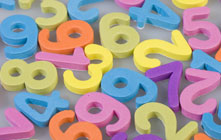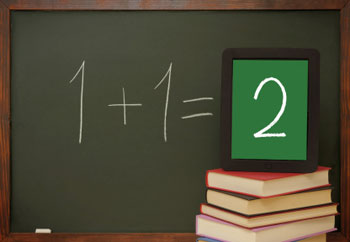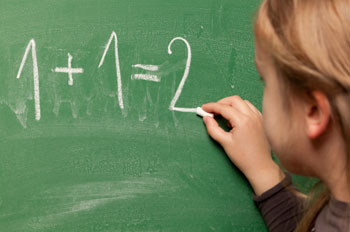Children's Math: Introduction to Area and Perimeter
Area and perimeter are two basic math concepts that you'll use frequently when you study geometry. Sometimes, you'll solve word problems that involve area or perimeter, and other times you'll be asked to find the perimeter or the area of figures that are shown in pictures.

How to Find the Area and Perimeter
Perimeter is the distance around a 2-dimensional figure, and it can be calculated by adding together the lengths of the figure's sides. Area is the amount of 2-dimensional space that a shape covers. For squares and rectangles, it's calculated by multiplying together the figure's length and width.
Area of a Rectangle
To find the area of a rectangle, you multiply the length of one of the shape's long sides, 'L,' by the width of one of its short sides, 'W.' The formula looks like this:
A = L x W
Multiplying the number of units in the shape's length by the number of units in its width tells you the total number of units that make up the shape. Usually, the 'units' are inches, centimeters or feet. For instance, you could find the area of a brick wall by counting how many bricks long and wide it is, and then multiplying these numbers together. If it were ten bricks long and 20 bricks wide, the wall's area would be equal to ten times 20, or 200 bricks (10 x 20 = 200). This method only works if all of the bricks are the same size, though.
Example: Area for Rectangles
Juanita wants to find the area of a soccer field that is 120 meters long and 90 meters wide. She uses the formula A = L x W, and multiplies 120 meters by 90 meters. She finds that the soccer field has an area of 10,800 square meters, because 120 x 90 = 10,800.
Perimeter for Rectangles
There are two ways to find the perimeter of a rectangle. One way is to add up the lengths of each side using this formula:
P = S1 + S2 + S3 + S4
Since the two long sides of the rectangle will be of equal length, and the two short sides will be of equal width, you can also use this formula to find a rectangle's perimeter:
P = 2L + 2W
This equation tells you to multiply the length of one of the rectangle's long sides, 'L,' by two, and to multiply the width of one of the rectangle's short sides, 'W,' by two. Then, it tells you to add these two values together to get the perimeter.
Example: Perimeter for Rectangles
Jorge is putting a fence around his vegetable garden, and he needs to find out what its perimeter is. He measures the garden and finds that it is 20 feet long and eight feet wide. He uses the formula for perimeter, P = 2L + 2W. He multiplies both the length and the width of his garden by two and adds the results together to get a perimeter of 56 feet. Here's how he did it:
P = 2(20) + 2(8)
P = 40 + 16
P = 56
Jorge could have also used the formula P = S1 + S2 + S3 + S4 to find the garden's perimeter. He could have added the values 20, 20, eight and eight together to get the same result, 56 feet (20 + 20 + 8 + 8 = 56).
Area for Squares
To find the area of a square, you multiply the shape's length by its width, just like you did to find the area of a rectangle. However, since a square's length and width are equal, multiplying them together is the same as multiplying the length of a side by itself. The formula is written like this:
A = s^2
Example: Area of a Square
Ellen has made brownies in a square pan with four sides that are each exactly ten inches long. She wants to find the area of the pan so she can figure out if she has enough brownies for her guests. She uses the formula A = s^2, where 's' equals ten inches. She multiplies ten by ten to find that the pan's area is 100 square inches (10 x 10 =100).
Perimeter for Squares
To find the perimeter of a square you can use the same formula that you used for rectangles (P = S1 + S2 + S3 + S4), since perimeter is equal to the sum of the lengths of a shape's sides. Another formula you can use to get the same result is this one:
P = 4s
This equation tells you to multiply the length of one of the square's sides by four. Since there are four equal sides of the square, multiplying the length of a side by four produces the same result as adding them together does.
Example: Perimeter of a Square
Franklin is putting a string of Christmas lights around his square bedroom, and he needs to know the room's perimeter so that he can make sure his string of lights is long enough. He measures one side of the room and finds that it's nine feet long. Then, he uses the formula P = 4s to calculate the perimeter. He multiplies four by nine to get the perimeter of 36 feet (4 x 9 = 36).
Other Articles You May Be Interested In
-
MIND Games Lead to Math Gains

Imagine a math teaching tool so effective that it need only be employed twice per week for less than an hour to result in huge proficiency gains. Impossible, you say? Not so...and MIND Research Institute has the virtual penguin to prove it.
-
Should Math Be a Main Focus in Kindergarten?

Should kindergartners put away the building blocks and open the math books? According to recent research, earlier is better when it comes to learning mathematical concepts. But that could put undue pressure on kids, parents and even teachers.
We Found 7 Tutors You Might Be Interested In
Huntington Learning

- What Huntington Learning offers:
- Online and in-center tutoring
- One on one tutoring
- Every Huntington tutor is certified and trained extensively on the most effective teaching methods
K12

- What K12 offers:
- Online tutoring
- Has a strong and effective partnership with public and private schools
- AdvancED-accredited corporation meeting the highest standards of educational management
Kaplan Kids

- What Kaplan Kids offers:
- Online tutoring
- Customized learning plans
- Real-Time Progress Reports track your child's progress
Kumon

- What Kumon offers:
- In-center tutoring
- Individualized programs for your child
- Helps your child develop the skills and study habits needed to improve their academic performance
Sylvan Learning

- What Sylvan Learning offers:
- Online and in-center tutoring
- Sylvan tutors are certified teachers who provide personalized instruction
- Regular assessment and progress reports
Tutor Doctor

- What Tutor Doctor offers:
- In-Home tutoring
- One on one attention by the tutor
- Develops personlized programs by working with your child's existing homework
TutorVista

- What TutorVista offers:
- Online tutoring
- Student works one-on-one with a professional tutor
- Using the virtual whiteboard workspace to share problems, solutions and explanations